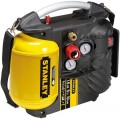Receiver
Air tanks, or receivers (for details, see "Receiver volume") for modern compressors are usually made in a shape close to cylindrical, and can have both horizontal and vertical arrangement. Each option has its own characteristics:
— Horizontal. Such receivers require quite a lot of space on the floor (or other surface), but this moment also has a “reverse side” — the area of the upper part of the tank is also quite large, and belt-driven mechanisms can be placed on it without problems (see "Drive") . In addition, the horizontal arrangement allows the use of tanks of almost any volume, from small to very capacious, and the compressors themselves are very stable — it is almost impossible to accidentally overturn such a device. Therefore, this option is by far the most common and is found in the vast majority of models.
— Vertical. The main advantage of such receivers over horizontal ones is the relatively small amount of space required for installation. On the other hand, the vertical layout imposes serious restrictions on the maximum volume of the tank, and a small amount of space on top is usually only suitable for direct drive systems (see above). And the stability of such structures is somewhat worse. Therefore, this option has not received wide popularity, and it is worth specifically looking for a vertical compressor only if the situation does not allow the use of a horizontal model.
— Is absent. Models supplied without any receiver at a...ll.
The main advantages of tankless units are compactness, light weight and relatively low cost. However the air flow from them is relatively uneven, but in many cases this is not a drawback; in addition, various solutions can be used in the design, to some extent compensating for this drawback, and some compressors without a receiver are even positioned as devices for the same airbrushing.

